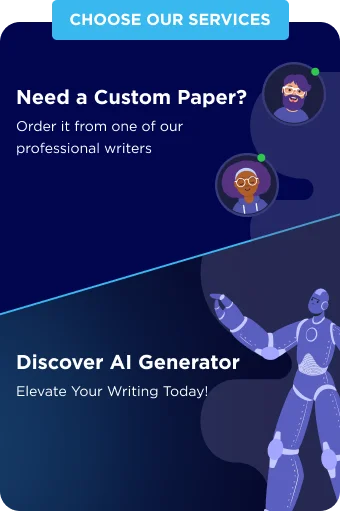Have you ever asked AI to write an essay sample only to find out that it’s rather feeble and doesn’t live up to all the hype around LLMs like ChatGPT and Bard? I’m sure you have. So have I. Yet, don’t rush to dismiss AI writing tools as useless. As any tool, it takes some time to master.
When it comes to AI, the key to excellent results is a good prompt. I bet your first attempt sounded something like “Write an essay about [topic],” – and that’s where the problem lies because AI generation is only as good as the prompt you feed into it. This has been known since the dawn of computing as the GIGO rule: garbage in, garbage out. Yet don’t worry, today we will learn how to write good AI prompts: just the right input to generate some gorgeous output.
What Is an AI prompt?
A prompt is a query that you give to an LLM (Large Language Model) in order to receive a specific response from it. In programming, prompts are commands or code snippets, but tools like ChatGPT made it possible to create a prompt in a natural language. Prompts can be as short as a single word or as complex as several paragraphs of detailed instructions. However, in my experience, it’s better to limit your prompt to several sentences, otherwise, some particular instructions tend to fall through the cracks in the LLMs’ logic, which no one seems to understand – even its creators.
In short, prompts are verbally expressed tasks you give to AI to generate text, translate, or receive informative answers to your questions. Writing good prompts isn’t as easy as it might seem at first glance. In fact, creating effective prompts is already a high-paying employment category called “prompt engineering.”
Luckily, you don’t have to get a degree to learn how to write prompts for AI. All you need is an understanding of some basic principles and a lot of practice. We are here to help you with the basic principles, but the practice is up to you.
By the way, you can try your prompt-writing prowess here:
How to Write Prompts For AI: General Guidelines
These are some general rules of thumb on writing great AI prompts no matter the task: college paper, blog article, short story, or information inquiry. To yield impressive results, keep this in mind as you craft your prompt.
Drop your Google habits
If you want AI to act as your private free essays writer, treat AI like an essay writer. That is, speak to it as you would to a human being. If you need an essay, request it as you would from a classmate, not from a search engine. Think, “Write me an essay about why people need friends and why friendship is considered so important and valuable in most cultures” instead of “Great essays about friendship.” When you adopt this tone, it will be easier for you to include little conversational details, explanations, and anecdotes that create a variety of possibilities as your dialogue evolves.
Give AI some context
Before you write, you always consider the rhetorical situation: who are your readers, what is the purpose of your text, what is the medium (speech, book, presentation, video, leaflet, etc.), what are some constraints (word count, time limit, specific form, etc.) Often, you don’t explicitly list it all, but you write with this information in mind. AI doesn’t have it – your prompt must provide it.
If you need an informative and helpful answer, tell AI a little about yourself too, for example: “I am a senior high-school student who doesn’t really like literature. In 800 words or less, tell me what Edgar Allan Poe’s The Tell-Tale Heart is about and what literary devices are used in it to create suspense. Persuade me to read it.”
Give specific instructions
The more generalized and vague your inquiry is, the more misaligned response you get. Instead of asking, “Write an essay about evil,” describe the perfect answer you envision in detail. For example, “Write a 1,200-word essay on the nature of evil for a college philosophy class. Explain some of the most popular perspectives on evil’s origin and purpose in the great scheme of things on the example of one situation/dilemma. How would different theories view it? Quote 6 sources and use simple English that a high-schooler would understand.”
Feed these two prompts into an AI of your choice and compare the results. See? AI isn’t as useless as you thought!
Assign it a role
Too often, people are disappointed in AI results when they ask it for advice and get answers like “I am a linguistic model, so I don’t have this experience” or “As a linguistic model, I cannot give you an opinion.” However, you can circumvent this problem by explicitly asking AI to act like someone: assign it an identity or profession. For example, “Explain why people need to study math even when they have calculators and don’t plan to work in STEM as if you were my teacher” or “Act like a doctor and explain to me the benefits and downsides of exercising for weight control.”
Provide examples
Of course, it’s fun asking ChatGPT to explain the theory of the Big Bang like a pirate or to write a sonnet about your cat like Shakespeare, but what if the style you need is a bit more obscure and lesser known? The rule “show, don’t tell” works here just fine. If you already have examples of the kind of text you want to emulate, provide them to AI. Feed it links or paste the text into a dialog window so it can parse your sample – it’s much more efficient than describing the style you need or pushing the “Regenerate” button in hopes that the desired result appears randomly. For example: “Write a 600-word backup report on an undergraduate level. Here are some good backup reports, write one like this about the [topic].”
Be creative
Don’t get discouraged if your first attempt doesn’t elicit the response you envisioned. Correct AI’s mistake, give it new directions, and use other keywords – thesaurus might help you find the right word to unlock the desired result. Don’t be afraid to experiment and play around with wording, but always state your objective clearly – ChatGPT is designed to recognize the intent. Pay specific attention to verbs – they are particularly important in conveying the intent. For example, “summarize this” or “condense this text” will typically get you a better result than “re-write this to make it shorter.”
As you can see, writing great AI prompts takes some imagination, trial, and error, but it’s not really rocket science.
Care to put all this theory into practice?
How to Write Good AI Prompts for College Papers
Now, let’s get a bit more specific and look at what you can add to your prompt to get a great sample for your college assignment with the help of AI.
Don’t just copy your prompt from the assignment sheet
Prompts from your assignment sheets and rubrics won’t do – they are written for you, the human. They ask you to analyze, ponder, assess, give your opinion, etc. AI can’t do this. If it were that simple, I wouldn’t need to write an entire article about how to write AI prompts.
Instead, scan your assignment for measurable things you can feed into the machine: specific paper type (argumentative essay, book report, etc.), word count, number of sources, number of points to argue, etc. Then, think of the paper you’d written and give explicit instructions to AI describing it. For example, instead of “What is your position on gun control? Explain your opinion,” it should be “Defend stricter gun control in the USA by giving three reasons why we need it regulated.”
Don’t ask it for quotes
It will give you plenty, but they will most likely all be fictitious – and by made-up people. Even if you insist on having some direct quotations from an existing expert you explicitly name, the quotes AI can give you will be generated based on everything this expert wrote, and AI can access. It will be something this person could say in a manner they probably would say it, but not the actual words you can trace back to any existing source.
Just accept it and move on. AI can cite sources of its information and concepts it explains, but it always generates by rephrasing existing texts – not lifting sentences and paragraphs as they are. If you need direct quotes in your paper, you will have to find them yourself and add them to the draft manually.
Embrace fact-checking
One final piece of advice, even though it’s not directly about prompts but rather about the results that AI returns. No matter how good your prompt is, no AI in the world will give you a state-of-the-art ready-to-submit paper. You should always fact-check evidence presented in the AI-generated samples because they don’t provide original analysis – modern AIs, even the most advanced and sophisticated, aren’t capable of doing this.
What they do is emulate samples they’ve been trained on, and depending on the topic, the result can be hit or miss. If AI mentions a study or a book, check if it exists. If AI gives you an expert’s name, check if this person is real. AIs know how to sound convincing, but they have a hard time telling actual reality and the reality reflected in texts apart. You have to be human to understand this distinction.
Writing good prompts for AI is easy to pick up but difficult to master. One of the biggest misconceptions about AI that stands in your way is perceiving it as sentient and able to understand your every word. It’s not. Explaining what you need to AI requires trial and error – a bit like writing a spell. A slight oversight might make everything go wrong, but a tweak in the right place creates magic. Sometimes, it takes hours and some weird strategies to find the correct phrasing, but finally making your prompt work is very satisfying.
Hope these tips help you find a common language with your favorite AI!















